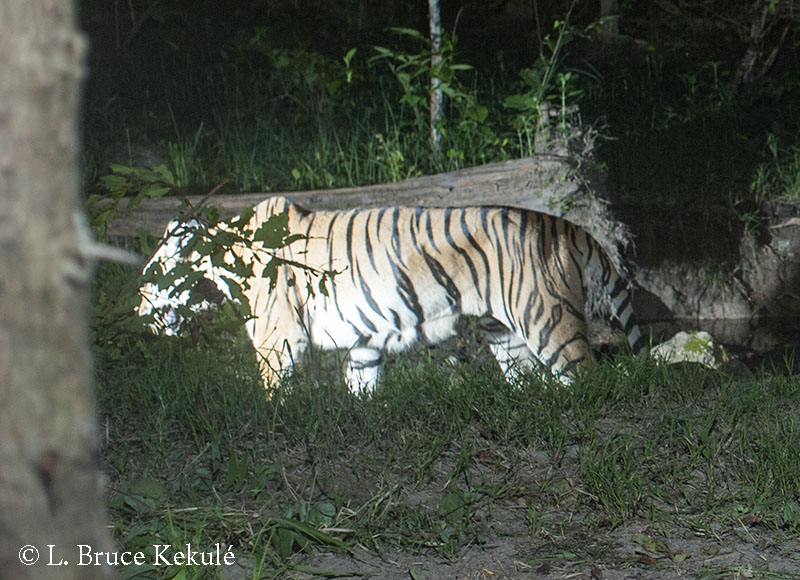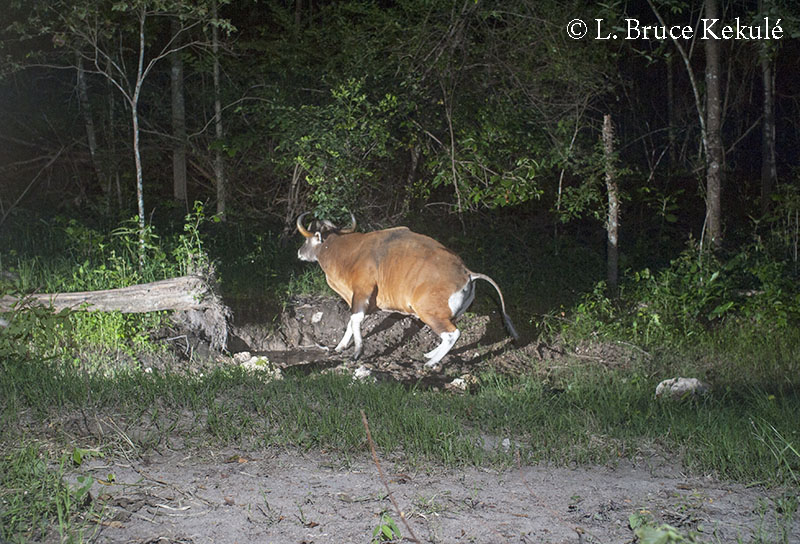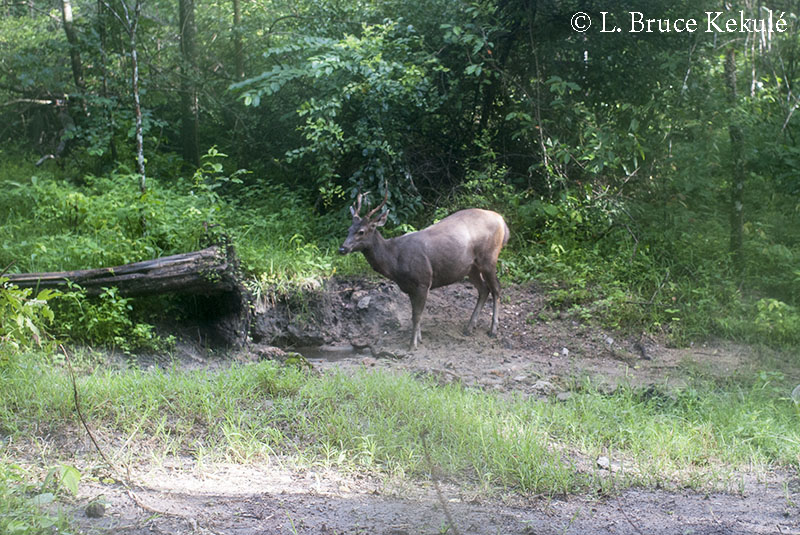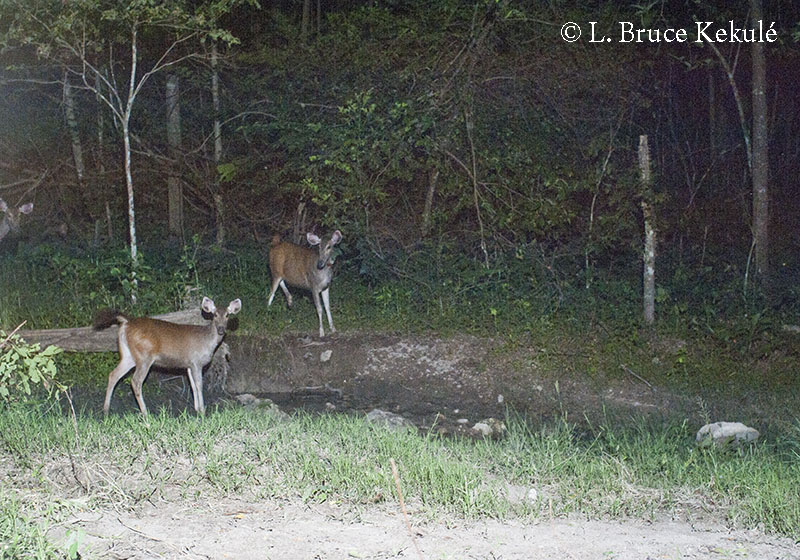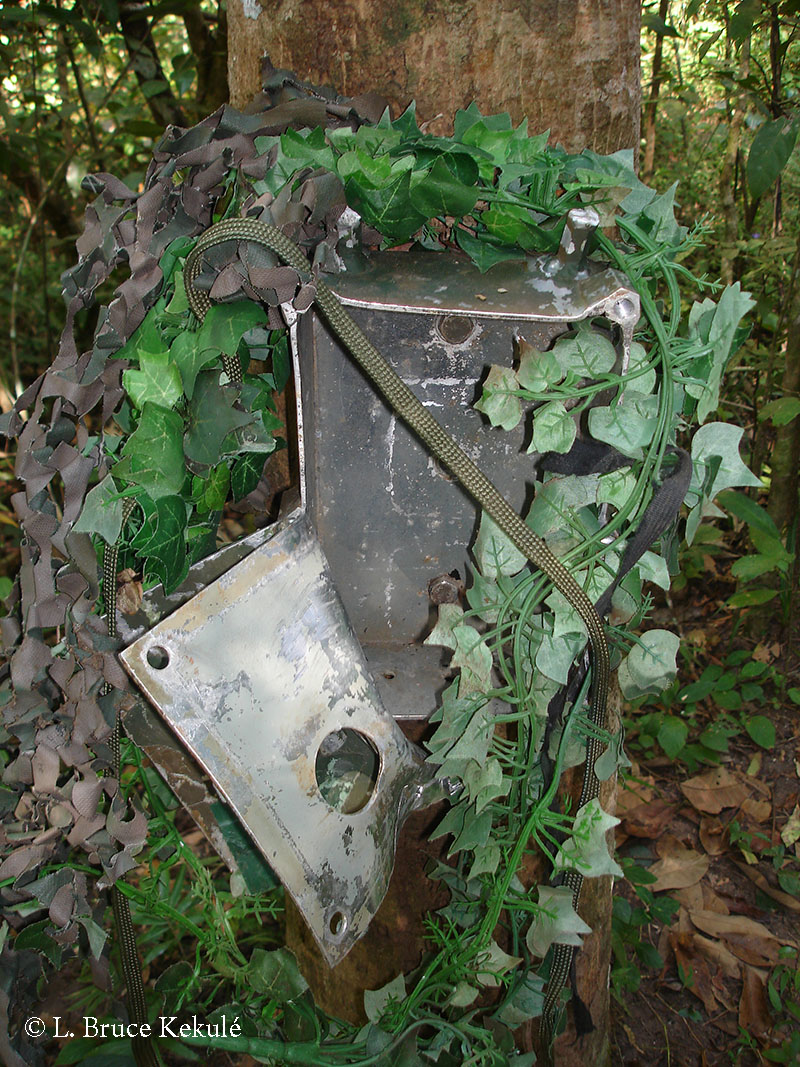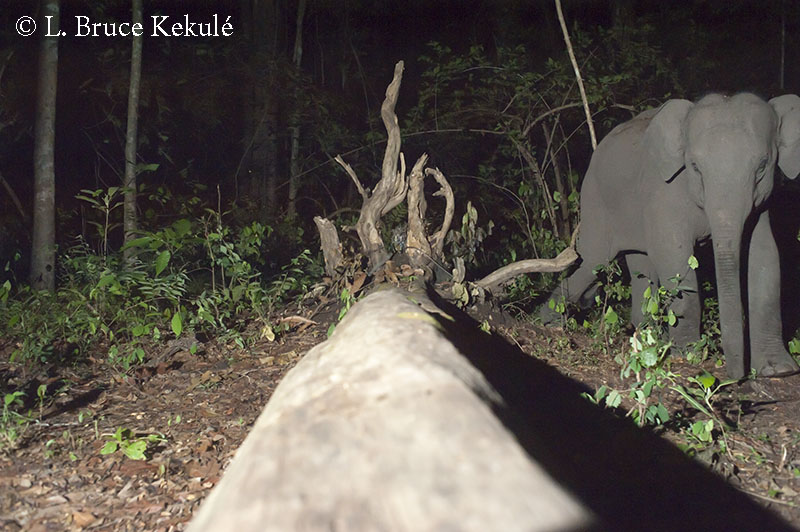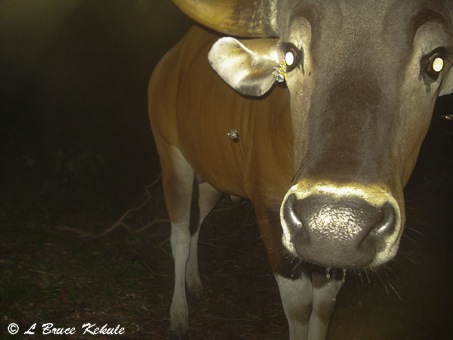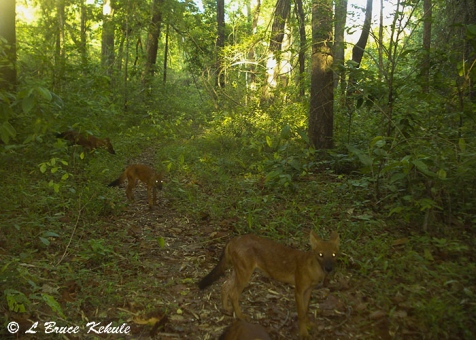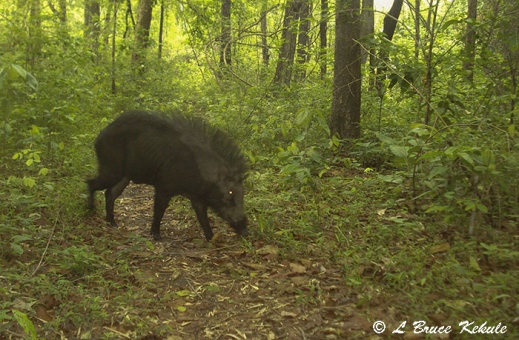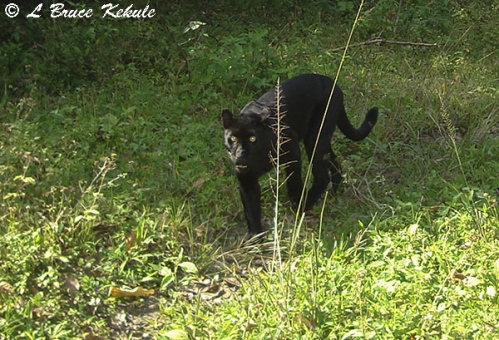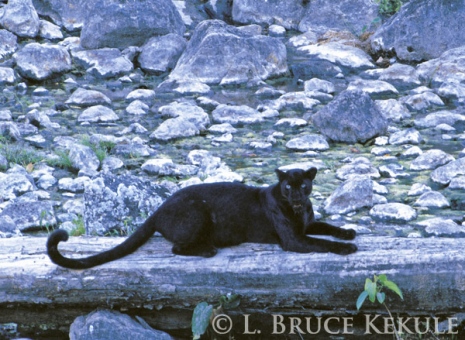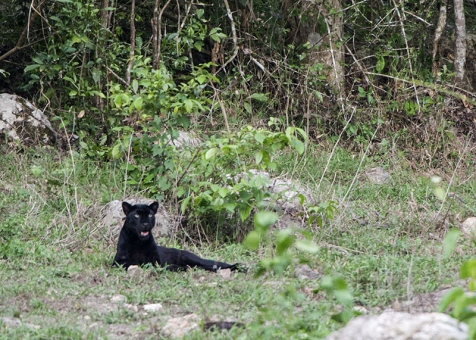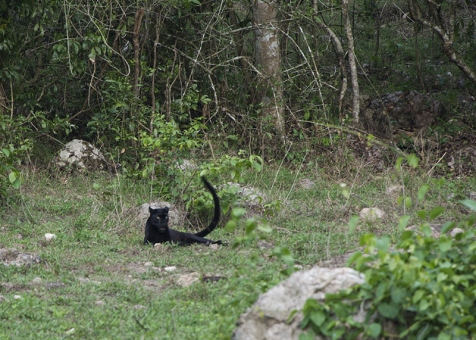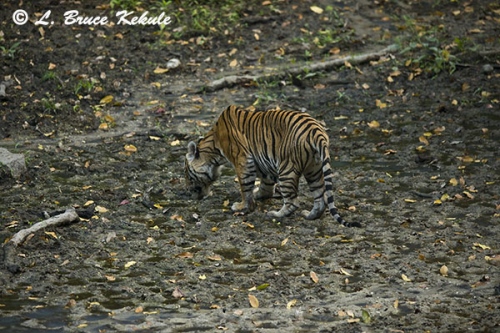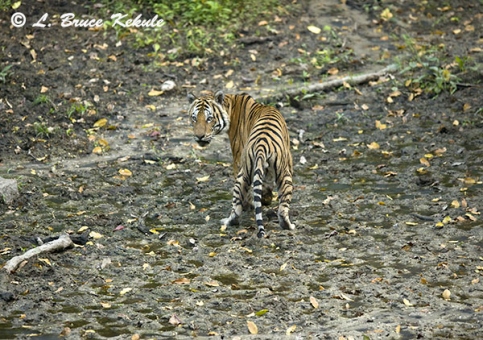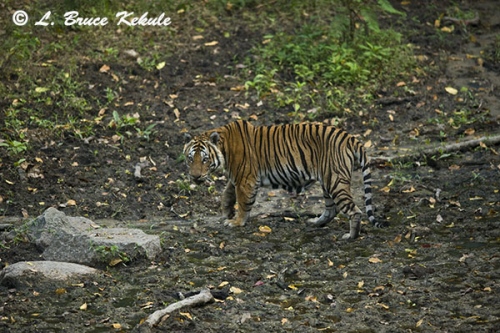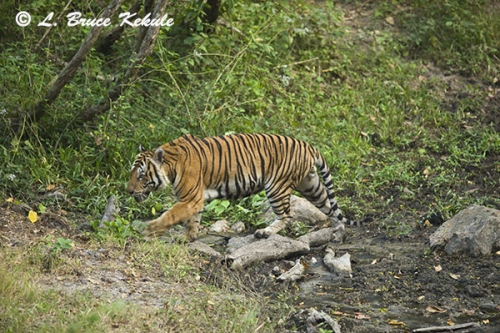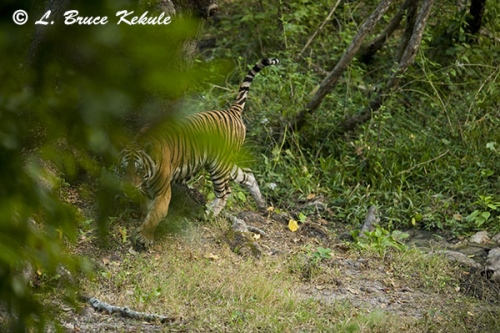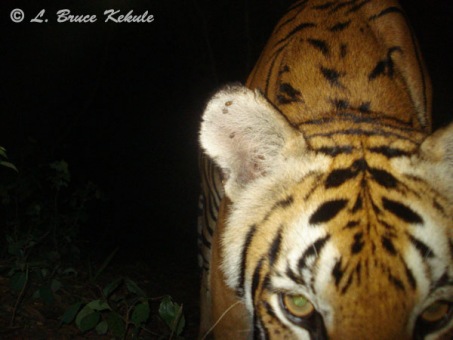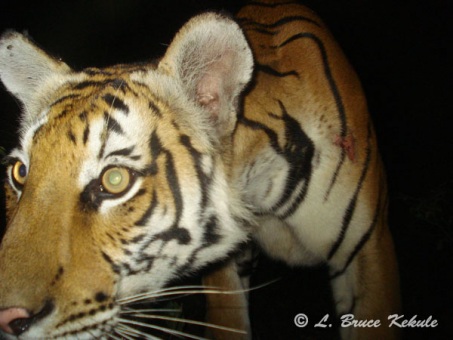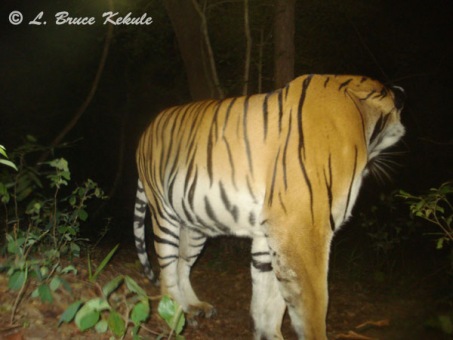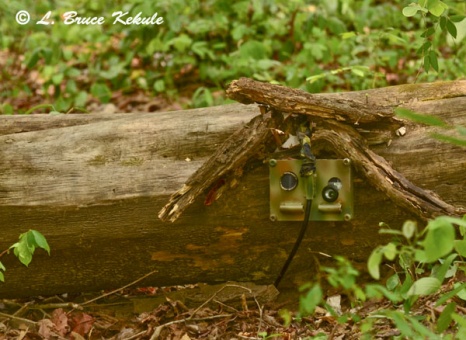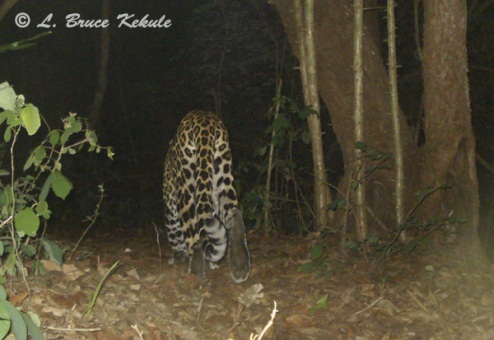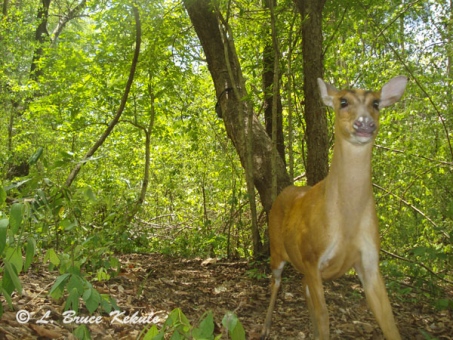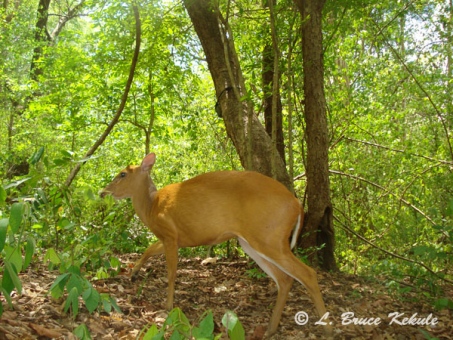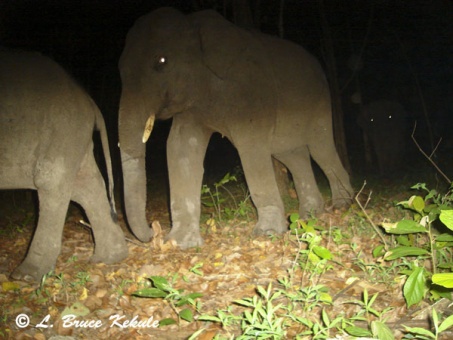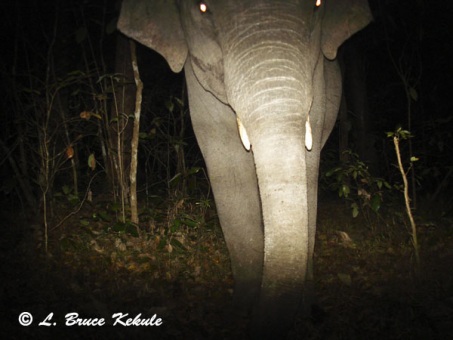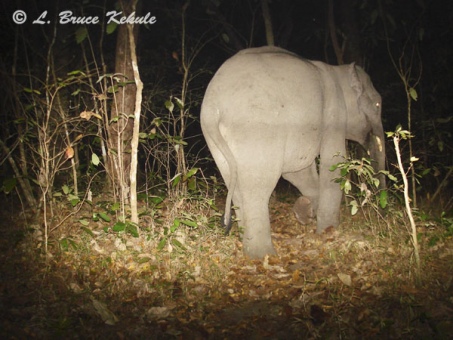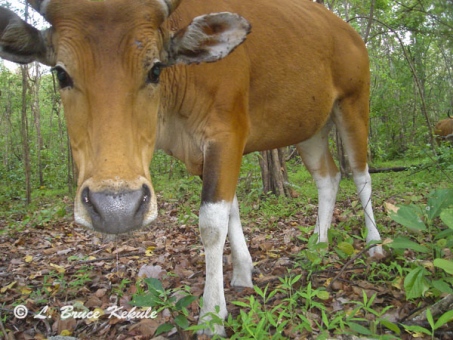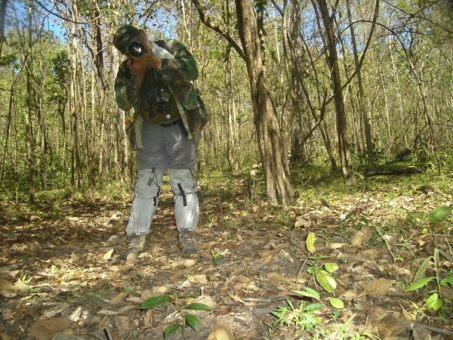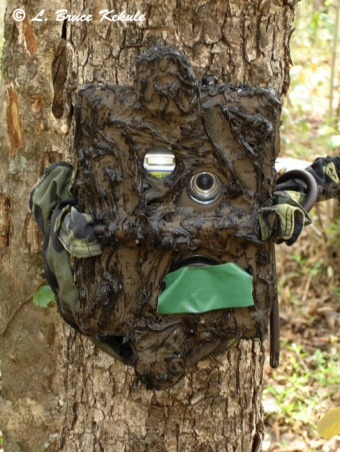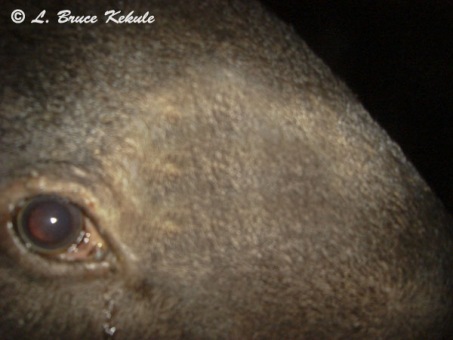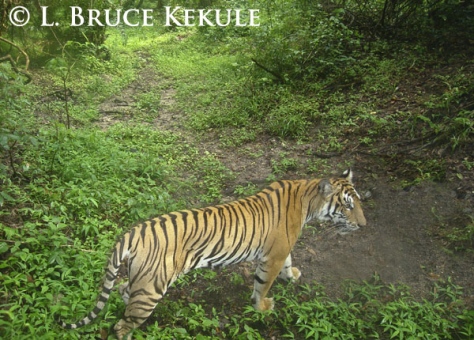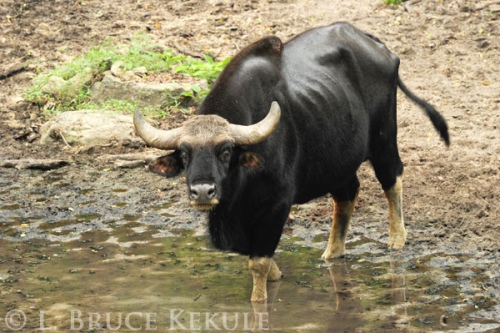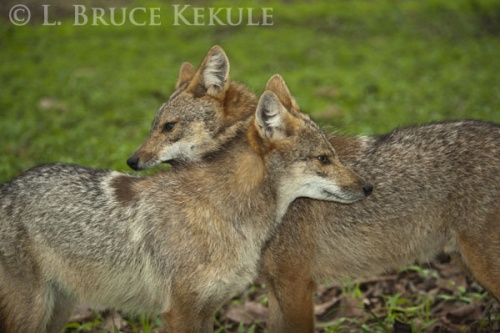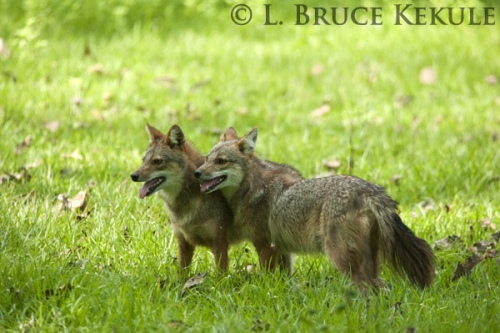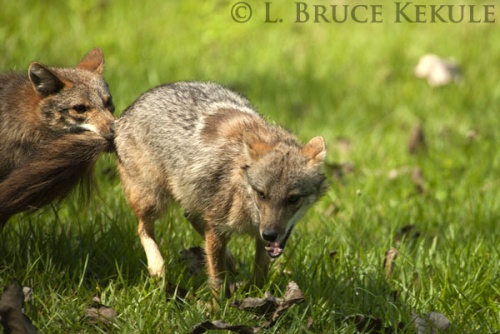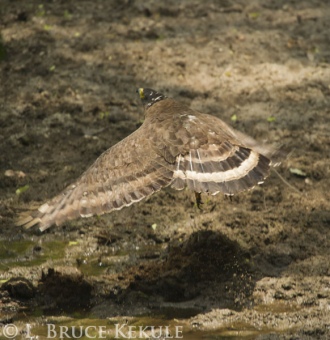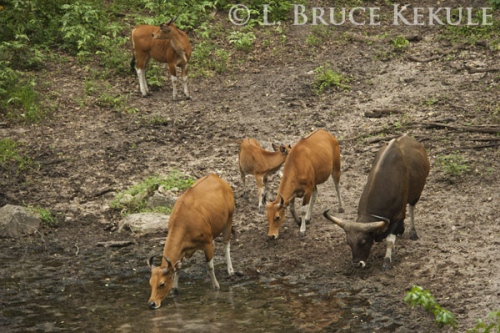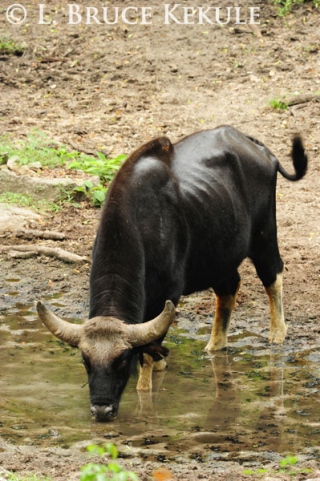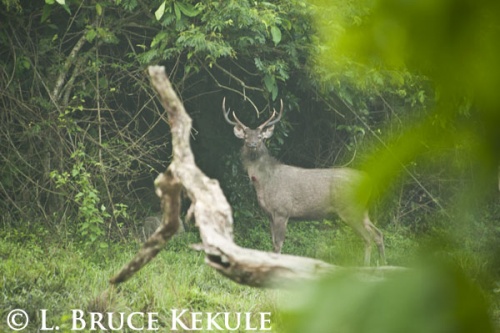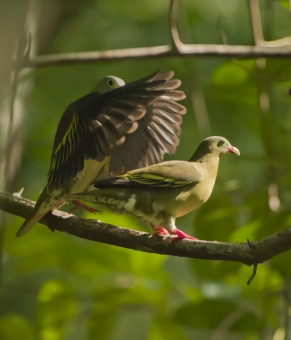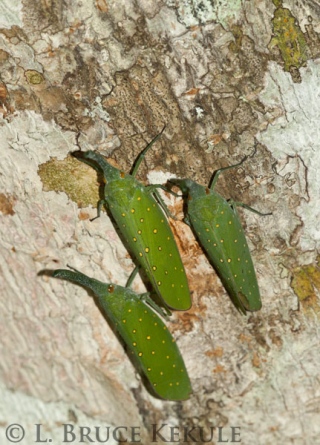Posts Tagged ‘Huai Kha Khaeng Wildlife Sanctuary’
A Close Encounter: The saga of a charging bull gaur
Gaur: Thailand’s magnificent mega-fauna
A truly close call with the largest bovid in the world…!
A bull gaur camera trapped at the trail-head a week before about 100 meters from where I was charged. Probably the same old bull that tried to kill me…!!
About two weeks ago, I hit the jackpot out of all my 48 years in Thai forests. I was alone and it was raining in the Western Forest Complex. I had just set a Bushnell Trophy Cam set to video at a trail-head where I previously got a big bull gaur, a bull banteng, elephant, black leopard, wild dog, tapir, wild pig and barking deer.
As I was walking in to set a few more traps, I saw some fresh gaur tracks and judging from the size, noted it was a big mature bull. I went in a little bit more and decided to turn back as the bush was really thick and it was getting late.
A mature bull banteng on the trail.
I had gone about 50 meters and all of a sudden, a bull gaur no more than six meters away, snorted at me. I snorted back thinking he would run away. In the next moment, this huge beast punched through the bush with its head down in the classic position to hook bad people and throw me into the trees.
I saw the right horn base for a fraction of a second and it took me another fraction of a second to do the only thing possible and that was to drop down to the left flat on my stomach with my head down. The bull jumped over my legs and then circled around to do more business of trying to kill me.
What seemed like a lifetime, I heard him thrashing around breaking saplings and stamping on the ground some 10 to 15 meters away. A second charge was imminent and could be disastrous if he used his hooves to trample me. Only one thing would save me now.
Banteng bull close-up.
I quickly pulled out my pistol (.45-ACP ‘Para-Ordnance’ alloy frame), loaded it and let off a shot in the air all the while still lying down. After the report a few seconds later, the bull high-tailed it crashing off into the forest behind me. WOW, that was a close encounter and truly a heart-stopper. I stayed on the ground for quite awhile to make sure he was really gone.
In all my years in the forest, I have never been this close to a gaur or had the experience of a charging bull. No telling if this old bovid had been shot and wounded previously by poachers, and that he really hated humans. Or was he just an old guy with a bad temper and considered me a threat when I barked back at him. I will never really know how close I came to instant death…!
Many a Thai hunter has been killed by gaur because they froze in their tracks and just stood there not reacting in time. I have read in several books that the only way to avert death is to drop flat on all fours with your head down, or to have a very large caliber rifle (minimum .458 caliber) on ready. I had a Nikon D7000 and a 70-300 VR lens. I was lucky to be packing a sidearm..!!
A black leopard close-up.
How did I react so fast and survive? I have one man to thank. He is my dear old friend Gordon Young, author of the book ‘Tracks of an Intruder’, a classic tome about hunting in northern Thailand in the 1950s. He talks about the evasive action needed in this urgent situation in a chapter about a man-killer bull gaur in Mae Salak in Chiang Mai, Northern Thailand. I certainly thought of him right after this…!
I feel extremely lucky to have survived this attack and it was absolutely the most exciting experience that I have ever had, bar none! I have been two meters away from a black leopard just outside my blind, and that did not even hold a candle to this charging solitary bull. I certainly did not have time to take a photo.
Maybe being born under the star ‘Taurus’ (May 19th) had something to do with it, or maybe the ‘good old spirits’ of the Thai forests took care of me and pushed me down at the right moment. This incident surely has me thanking my lucky star.
Asian wild dog pack out hunting.
Gaur are wild forest ox and the largest bovid in the world standing 1.7 meters at the shoulder weighing close to a ton for mature bulls with a distinctive dorsal ridge and a large dewlap, forming a very powerful appearance. Cows are only about 10cm shorter in height, but are more lightly built and weigh 150 kilograms less.
These beasts have stout limbs with white or yellow stockings from the knee to the hoof. The tail is long and the tip is tufted to ward-off biting insects. Newborns are a light golden color, but soon darken to coffee or reddish brown. Old bulls and cows are jet black but south of the Istamas of Kra, some take on a reddish hue.
All bovine share common features, such as strong defensive horns that never shed on males and females, as well as teeth and four-chambered stomachs adapted to chewing and digesting grass. Their long legs and two-toed feet are designed for fast running and agile leaping to escape predators. They are gregarious animals, staying in herds of six to 20, or more. A large herd of 50 was recorded in Thung Yai Naresuan Wildlife Sanctuary but that was a long time ago.
Wild boar in the morning.
Due to their formidable size and power, gaur has few natural enemies. Tiger, leopard and Asian wild dog packs occasionally attack unguarded calves or unhealthy animals, but only the tiger has been reported to kill a full-grown adult. Man is their most dangerous adversary.
These herbivores graze on grass but also browse edible shrubs, leaves and fallen fruit, and usually feed through the night. They also visit mineral licks to supplement their diet. During the day, they rest-up in deep shade.
A male muntjac (barking deer) with a serious wound on its hind quarter.
Gaur still survive in some protected areas but are in serious decline. It is now estimated that maybe 1000 remain in Thailand. However, some reserves where gaur are breeding in fairly good numbers allowing them to actually increase in number if there is adequate protection.
These enormous beasts live in herds but also become solitary, primarily the males. But I have also seen and photographed several mature females by themselves. Mineral deposits play a very important role in the lives of these wild cattle as does thick forests and steep mountainous terrain with abundant water resources. Their future depends whether they are protected to the fullest extent. Unfortunately, their beautifully curved horns are highly sought after by poachers and people who covet trophies.
A unarmed researcher a day before the big gaur passed by.
Budgets, better funding, more rangers and personnel are needed now. Transparency is a must with the national parks and wildlife sanctuaries so money is used properly and efficiently, and corruption stamped out completely. Now that will be a tough nut to crack. It is hoped this draconian situation will change, so the Kingdom’s natural heritage and the majestic gaur will continue to survive in today’s world.
Additional photos of gaur:
My first encounter with a bull gaur some 15 years ago.
The older bull being chased by a younger one.
Another old bull gaur at a waterhole.
A single gaur cow at a mineral deposit.
Gaur herd including a bull, cows and three calves.
A gaur herd including two banteng in Kui Buri National Park.
A bull gaur track on the right and cow track above.
A Black Leopard in Broad Daylight
A rare encounter: A black cat appears deep in the interior of the Western Forest Complex
My first black leopard in the late afternoon sun showing its spots some 15 years ago.
It is late April in the forests of the Western Forest Complex, one of my favorite places in Thailand. The first rains have come and doused the dangerous forest fires that spread throughout the area during the dry hot season starting in March and ending in May.
As usual, I’m setting-up camera traps at a hot-springs (mineral deposit) not far from a ranger station some 50 kilometers deep in the interior accessible only by a dirt road.
This natural seep is visited by all the large mammals including tiger, leopard, elephants, gaur, banteng, tapir, sambar and many other smaller creatures, and provides excellent opportunities for some great animal shots.
As I was going through a few of my camera traps changing out cards and batteries, I decided to have a quick look at a 2GB card that was in one of my cams.
A black leopard in mid-afternoon camera trapped on a trail to the hotspring.
Imagine my surprise to see a shot of a ‘black leopard’ in mid-afternoon walking up a trail shown in the story. Other denizens caught in this series include elephant, tapir, sambar, wild pig and muntjac (barking deer) over a month period back in February of this year. The leopard was truly a bonus and I had actually closed out the program with this cam.
This black leopard brought back fond memories of this place more than 15 years ago. I was sitting in a tree blind up by the hot springs when a black leopard walked out into the open about 4pm and posed for me at several places for over the next hour.
Those were in the old days of slide film, and I did not know how good the shots were until the film was processed. A few images are shown here from that lucky sequence many years ago. The sun was low and the black leopard showing its spots is one of my best wildlife photographs ever.
Posing on a fallen tree at the beginning of my career of wildlife photography.
Sometimes things happen in succession that boggles the mind. On May 6th, I posted the ‘black leopard’ camera trap image on my website. The next day I left Bangkok very early in the morning and arrived at the hot springs. I was back to reset camera traps, and this time to sit at the base of the old tree for some through-the-lens work. Who knows what might show-up.
Resting in the late afternoon and scoping out the area for prey, May 2013.
This black cat stayed for about 10 minutes.
A rare carnivore still surviving in Thailand.
Another once in a lifetime encounter as it leaves the mineral deposit.
I was with my good friend Sarawut Sawkhamkhet, a Thai wildlife photographer. We arrived and set-up a temporary blind about 3pm. The weather was warm and balmy with nice clear-blue skies.
At 5:45pm, the unthinkable happened! A ‘black leopard’ appeared out of the forest near the springs and walked over for a drink, and then disappeared for a short while. Then this magnificent creature came back and flopped down on all fours twitching its tail looking straight at us and staying for about 10 minutes before going back in the forest where it had come from.
The leopard (Panthera pardus) described by Linnaeus in 1758 is the second largest cat in Thailand. Once upon a time, leopards could be found in most forests of the Kingdom. These felines are still surviving quite well in protected areas in the West, and many forests in the South. The central, eastern and northeastern regions have no reports of leopard for long time now.
Pound for pound, the leopard can take on some seriously large animals several times its size. The leopard is closely related to the jaguar of South America. Both have a spotted coat pattern and incidence of ‘melanism’ or black phase. Many people have a misconception about the black leopard (also known as the black panther) as a separate species but in fact, it is the same as the yellow phased leopard.
The present distribution of the leopard is restricted to Asia Minor, India, Southeast Asia, the Himalayas, Tibet, China, Siberia, and Africa. Fossils of leopards have been found in Pleistocene deposits throughout Europe, the Middle East, Java, and Africa, some 1.5 million years old, indicating the leopard arrived after the tiger which has been around for about two million years.
These secretive cats are mainly nocturnal but in some localities, they are active in the day too. Their populations and ranges are difficult to determine but radio tracking of collared animals has shed new light on their movements and areas they live in.
Sighting a leopard in Asia is extremely difficult, and even catching a rare glimpse of this very essential top predator is tough due to its solitary and stealthy behavior. However, luck can sometimes play an important part in viewing the leopard and I feel lucky to have seen and photographed them on quite a few occasions.
My most thrilling or heart stopping adventure with a black leopard happened in Huai Kha Khaeng about five years ago while I was sitting up on a bluff overlooking the river. A photographic blind was erected on the rock-face about 20 meters up with a small trail that enabled me to get into the hide. The sun was bright and the weather was warm during the dry season.
About 9am, several monks down by the river passed on but did not see the camouflaged structure as they went their way. After that, I came down for lunch and set some camera traps at a mineral deposit nearby. At 2pm, I settled back in the blind and began a vigil of the river. I started to feel a bit groggy as the sun was beating down on my position. I moved my camera in to save it from the direct sunlight.
All of a sudden, I was startled by a guttural growl outside the enclosure. I stood up peering out the window and came face to face with a huge round black head and yellow eyes about two meters away that penetrated my soul. My first instinct reaction; it was a big black dog. But that quickly changed as the creature stared intently at me before bounding down the trail it had come up. The big cat was gone in a split second. Of course there was not enough time to get any photographs. The incident surely is etched in my memory.
Without doubt, the future of the leopard depends on one thing only – the complete protection of the remaining forests where they live. If the national parks and wildlife sanctuaries remain intact with a high number of prey species, the big cats will survive. But if over-development, poaching and encroachment are allowed to continue, the large cats will eventually disappear.
Unfortunately, too much time and money is wasted by too many organizations talking about saving wildlife and their habitats, with very little actually being done. Human population growth will eventually destroy most wild places. Only true protection by some dedicated people will slow the destruction of nature’s precious wildlife and wilderness areas. It is hoped the leopard, and the tiger, will continue to survive as they have for millions of years.
A ‘Black Leopard’ again..!
An extraordinary sighting in Huai Kha Khaeng Wildlife Sanctuary
A black leopard resting at the hot spring.
Sometimes things happen in succession that boggles the mind. On May 6th I posted a tale about a ‘black leopard’ plus other Asian wild animals caught by my Sony S600 cam on a trail into a hot spring in Huai Kha Khaeng Wildlife Sanctuary, western Thailand where I’m currently running a camera trap program.
Entering the hot spring.
I also mentioned in the story that I photographed a ‘black leopard’ from a tree blind some 15 years ago just up the trail a bit. The ‘leopard spots’ image is one of my all-time favorite wildlife photographs ever. http://brucekekule.com/camera_trapping/a-black-leopard-passes-my-camera-trap/
Leaving the hot spring.
On May 7th, I was back at the hot springs to set camera traps, and to sit at the base of the old tree for some through-the-lens work. Who knows what might show-up.
I was with my friend Sarawut Sawkhamkhet, a Thai wildlife photographer. We arrived and set-up a temporary blind about 3pm. The weather was warm and balmy with nice clear-blue skies.
A full-frame shot.
At 5:45pm, the unthinkable happened! A ‘black leopard’ appeared out of the forest near the springs and walked over for a drink, and then disappeared for a short while. Then the magnificent creature came back and flopped down on all fours twitching its tail looking straight at us staying for about 10 minutes before going back in the forest where it had come from.
Kabook Kabieng hot springs deep in the interior.
I would venture to say, this is the same cat I camera trapped back in February and it could also be an offspring of my original leopard back in 1998. Who knows? I was elated to say the least.
To see and photograph a black leopard once again at this same location after all these years is something out of the extraordinary. When time permitted, I set one of my trusty Sony S600 cams at the hot spring and will go back in a couple of weeks to see what has visited the waterhole.
Then I intend to set a DSLR Nikon or Canon camera trap with several flashes for improved images. This place is truly worth the effort, time and difficulty to get here. I look forward to more incredible images from this wildlife haven.
Indochinese tiger sequence
The following images are my best of an Indochinese tiger caught in late afternoon in Huai Kha Khaeng Wildlife Sanctuary, Uthai Thani province, Western Thailand on December 11, 2009. This male moved through the waterhole and did not stay. I had just enough time to get 20 lucky shots of the big cat. A rare sighting of an elusive carnivore..!
Tiger moving into waterhole at 5 pm
Tiger takes a quick drink.
Tiger takes a first look at my location.
Tiger stops and take a second look.
Tiger moves on.
Tiger takes one last look.
The highlight of my wildlife photographic career and a dream come true….!
Photos taken with a Nikon D700 and a 400mm f 2.8 lens on a Gitzo tripod. Exposure: 1/60 sec; f/2.8; ISO 800
Huai Kha Khaeng: A birthday tiger and leopard
A new Sony W55 trail camera catches the big cats
On May 19th (my birthday) 2012, I decided to celebrate in the forest after returning to Thailand from a two-week photographic safari in Africa. It was once again a great trip to the Dark Continent and I managed to photograph the ‘Big Five’ (three times now) plus a multitude of other animals including some rare species like black-mane lion, black rhino, striped hyena, sable antelope and bush baby. I also got many other common animals like elephant, buffalo, giraffe, zebra, warthogs and antelopes. I also managed to catch Mount Kilimanjaro when the clouds lifted. Kenya is absolutely one of the greatest natural spectacles on the planet and I look forward to returning next year.
A male leopard caught by a Sony W55 homebrew trail camera trap
However, there are still a few wild places in Thailand that harbor many magnificent Asian creatures such as tiger, leopard, elephant, gaur, banteng plus many other mammals, birds, reptiles, insects and plant species. Huai Kha Khaeng is one of the top wildlife sanctuaries in Southeast Asia, and the world for that matter.
Leopard caught again checking out the camera
To get there, it takes about five hours by vehicle from Bangkok and is tucked away in the forested mountains of central-western Thailand in Uthai Thani province. I have written many stories about this place and its wildlife, and it never fails to live up to its status as a ‘World Heritage Site’ but this time it turned out even better than my wildest dreams.
A young female tiger caught by the Sony w55 trail cam
My birthday wish to catch a tiger and leopard up-close with one of my camera traps was granted by the ‘spirits of the forest’ and all the hard work building the cams, setting them up, waiting while they soaked and then the pain-staking collection was truly worthwhile.
My favorite shot of this young tiger
Arriving early in the morning, I got everything ready and went out to check the cams. One location has been extremely productive and had been very lucky catching tiger and leopard almost every time (three months in a row). When I went through the photos on my new Sony W55/SSII/1020/3 AA externals, I could not resist shouting out loud with one big hurrah. A leopard had stopped at the cam for a few shots and a night later, a tiger posed for a whole series of close-ups from the low-down set-up. I was speechless for a few seconds.
Check-out the ticks and markings on the right ear
Remember this tiger eye and ear
This game trail is situated deep in the protected area and many animals use it to get to a mineral lick and waterhole. The balance of nature is in full force here and ‘eat or be eaten’ carries on everyday. There is a fallen tree right across the trail about 500 meters from the dirt road some 15 kilometers in the sanctuary.
More ticks and note the wound on the left shoulder
Both of these big cats jump this log as they hunt for prey but usually a few days or two apart. The leopard is a very mature male but the tiger is a young female that seems to may have finally left her mother. I have a close-up shot of this same cat captured together in March and identified it as the same tiger two months ago by markings on the right ear. What a coincidence!
Stripe-pattern on right side used to identify this cat
All I can say is: this has been the best birthday in many moons and I know that my prayers are really answered from time to time. It is hoped this young tiger will continue to live out its life in safety and carry on its legacy as the world’s largest cat. Huai Kha Khaeng is truly a remarkable place and I have not even scratched the surface of this amazing wilderness!
Huai Kha Khaeng ongoing camera trap saga
New camera trap gets a leopard and tiger first time out
Sony W55 in Otter 2000 case with a Snapshotsniper SSII board and 3 AA externals
The feeling of accomplishment is the best part of building a ‘homebrew’ trail camera and then sharing the photos with others. I am extremely lucky to be working in a place that is one of the top tiger reserves in the world, and is extremely productive for camera trapping. It is not only the tigers, but also other predators like leopard, wild dog and jackal, and their prey species such as deer, pig and wild cattle that makes Huai Kha Khaeng Wildlife Sanctuary truly special.
A leopard caught by the Sony W55 camera trap
When I first built this unit, I had one fallen tree across a trail in mind and it proved to be the right choice. I designed the cam to slip the 10mm ‘Python’ locking cable around the horizontal log. One of the first animals to jump over was a mature male leopard several nights after the setup. This frame filling shot is what I was hoping for.
Leopard caught again as it went down the trail
Several nights later, a tiger went over and the W55 caught its rear end as it disappeared down the trail. A female muntjac (barking deer) was also caught. This was after only a 15-day soak and shows the tremendous biodiversity of this amazing place. This unit definitely worked as designed: to scout a game trail with a low-down set-up.
Tiger caught going down game trail several nights later
The next order of business now is to build a Nikon ML-3 ‘active-infrared’ controlled SLR Nikon F5 film camera using Fuji Provia 400 ISO slide film, and a Nikon D2x DSLR and both can fire five shots a second in ‘continuous mode’ with several wireless SB600s or SB28s. These two cameras are my old prime camera bodies that I have kept over the years (they were really expensive), and I have resurrected them for this project. The Nikon D2x is now in the Nikon shop for an overhaul but will be finished real soon.
Female muntjac (barking deer) caught by the camera trap
My main objective is to catch the cats making the jump. I will eventually be installing both units close together on either side of this log about a meter or so away from the trail. The sensors need to be slightly angled away so as to activate them a bit early. Both cameras will be using an 18-35mm wide-angle lens (the zoom setting of the lens will be adjusted when installed) and that should help to catch these quick-acting animals. The units have to be precise and fast, and fire off a good string of shots with several flashes.
Muntjac spooked by the camera’s flash
The only negative aspect with active infrared at night; the first shot will not trip the flash but follow up shots will be OK. But I can also hard wire a flash for each cam with a sync-cable in conjunction with the wireless flashes and that should be enough. I will also experiment with a ‘passive infrared’ system that can wake-up the flashes in time for the shot. However, this is a hit and miss situation whereas active infrared is usually spot on and will trip immediately after the beam is broken.
The system will be modular so sensors and camera are separate, and they will be ‘plug and play’ units. That’s the plan anyway for this absolutely amazing wildlife game trail. I have all the parts ready; just finding time to put it all together is the next trick.
Got a very busy schedule with a trip to Africa and the States for the next couple of months. But I will be getting the SLR and DSLR camera traps up and running shortly after getting back to Thailand, and of course will post the builds. Most important: they have to be ‘elephant proof’ but I have that covered as usual.
Posted from Tsavo National Park, southern Kenya, Africa
Huai Kha Khaeng: A camera trap saga
Thailand’s amazing forest with some beautiful, elusive and rare Asian creatures
Huai Kha Khaeng Wildlife Sanctuary is situated in central western Thailand, and is a World Heritage Site. It is the top protected area in the Kingdom. In January 2012, I began a camera trap program to determine the status of wildlife found here. In just a short two months, all the large mammals including elephant, gaur, banteng, tapir, tiger, leopard and many others have been caught by ‘homebrew’ digital camera traps set at various mineral deposits, water holes and game trails situated in the interior of the sanctuary. I have ten trail cams working through till March 31st, 2012. These are the best series. The following photos shows this amazing biodiversity, and this place is truly worthy of its ‘World Heritage Site’ status.
Set-up Number 1: A S600/1010/SSI was set above a water hole close to a ranger station. This cam turned out the most wildlife photos over a two month period. This mineral deposit and waterhole is visited daily by many animals and is one of the best in the sanctuary.
A Sony S600/Pelican 1010/SSI in an ‘Elephant proof ‘ box with a ‘Python’ locking cable
Mature female tiger
Tiger follow-up shot
Young tusker elephant in a herd
Tusker close-up
Tusker about-face
Mature gaur bull
Mature banteng bull
Younger banteng bulls
Mature banteng cow
Banteng cow close-up
Macaque monkey
Camera trapper
Set-up Number 2: Another S600/1010/SSI was set close to the ranger station and a bag of large rotten fish heads was strung up to prevent being taken by a scavenger like a water monitor. Amazingly, a leopard and a big wild boar, both scavengers, came to the bait. The bag can be seen in the boar picture. Boy did it smell..!
S600/1010/SSI in ‘elephant proof’ box with python locking cable.
Leopard male in the stream attracted by the ‘fish head’ bait.
Wild boar hoping for some carrion.
A crab-eating mongoose in the stream after the bait had been cut down.
Set-up Number 3: An old Sony S600/1040/BFOutdoors/2 ‘C’ cell externals in an ‘elephant proof’ box and ‘Python’ locking cable with 3D camouflage was used to catch this tiger mother and her cub (also caught by Bushnell Trophy Cam video twenty meters away). Other shots collected from this cam were deer at night not included here.
Sony S600 in a Pelican 1040 and BFOutdoors board with 2 ‘C’ cell externals
Tiger mother caught close to Subkaow mineral deposit and water hole
‘Eye of a tiger’ as this young cub has a chew on the cam…remarkable shot…!
Set-up Number 4: An older S600 with a Yeticam board in a 2nd generation LBK aluminum boxed cam plus tools for installation. Tiger, tapir and a sambar stag came along this trail about a day’s walk from the ranger station I stay at. This site will be covered by long-range cams with ‘C’ and ‘D’ cell externals for a three-four month period during the rainy season.
Old 2nd generation LBK trail cam in an ‘elephant proof’
housing firmly bolted to a tree with a ‘Python cable and 2 lag bolts.
Rear-end of a tiger along a game trail
Asian tapir at night
Tapir up-close and checking out the cam
‘Eye of a tapir’….not as dramatic as a tiger’s eye..but OK for government work..!
A mature sambar stag, Thailand’s largest cervid
Note: I still have more then ten trail cams working here at the moment including my new Canon DSLR 400D with three wireless flashes, and two of my new W55s. I will also be setting up a homebrew video very soon. I surely will be posting many more camera trap photos of this truly wonderful and magical wildlife sanctuary in the near future.
Escape to Nature – Photographing rare animals
Visiting the forest during Songkran: Thailand’s New Year and water festival
Huai Kha Khaeng reveals some wild endangered Asian creatures
Indochinese tiger camera-trapped in Huai Kha Khaeng
When I was 19 years old, I arrived in Bangkok at the end of March spending a week or so in the ‘City of Angels’ enjoying the sights and sounds. This was in 1964 just as the Vietnam War was getting into high gear. Pollution was mild and the klongs were not that bad.
I remember riding around in Datsun Bluebird taxis with no air-con and watching the road flash-by between my feet. The gaping hole made me nervous but the capital was an amazing experience all stored in the old memory bank.
Banteng bull and cow at a waterhole in Huai Kha Khaeng
After the hustle and bustle of the city, Dad and I caught the train headed north to Chiang Mai. The next morning at dawn, we passed through Phrae province surrounded by misty mountains. I opened the window and the cool breeze was refreshing. I instantly fell in love with the countryside and decided that Thailand was for me.
We arrived in the northern capital just in time to celebrate Songkran water festival for the very first time. As a teenager, it was a blast. But it was still tough getting around on my motorcycle as the main object of some people especially at intersections was to kill the bike, and then completely drench the rider (me) with water and powder.
Bull gaur arrived at the same waterhole a few minutes after the banteng
Yes, downtown Chiang Mai and the surrounding countryside was a madhouse even back in ‘64’. Songkran lasted for more than seven days in the north starting a few days before April 13th and finishing up a couple of days after the 15th.
As Thailand’s northern forests and mountains provided plenty of water for the festival, there was a seemingly unlimited supply. The watersheds were still very healthy at that time. In late March – early April, the temperature was cool in the evening and warm to hot during the day.
Crested Serpent-eagle flying out of the same waterhole
Eventually I met-up with some fellow Americans and the three of them are life-long friends to this day. John C. Wilhite lll was attending classes at the newly built Chiang Mai University, and his father was a Major in the U.S. Air Force for JUSMAG (Joint US Military Advisory Group) advising Royal Thai Air Force personnel on tactics and operation of AT-28 training aircraft. Johnny and I still continue to communicate after all these years.
Wayne (Beak) Sivaslian and Ed (Mac) McDonnell with the U.S. Army were stationed in Chiang Mai. Their mission was sensitive and classified but we were close friends and still are to this day. We recently held a 40-year reunion back in the States.
Asiatic jackals at a ranger station in the interior
When Songkran rolled around, we got out the old U.S. Army deuce and a half (2 1/2 ton truck) and took off the tarp and filling the back with three or four 200-liter drums with water and ice. We then headed downtown to do battle. As we were higher up than most, we had an advantage and usually won the water fights. At the end of the day, our lips, hands and feet would turn blue and we would be shivering but boy was it fun. Finally, the police outlawed trucks with large drums of water but that did not last long.
Asiatic jackal on the run
One year, I took my family including the wife and daughter plus all the in-laws out on the town in the back of my old Series One Land Rover with no cover, doors or windows. I was the driver and had to keep my wits about me. As we were nearing Suan Dok Hospital, a drunken hooligan dipped a bucket full of dirty klong water to the brim. He then threw the entire load straight into my ribs and face with extreme force from a distance of less than a meter, and that really hurt. All he did was laugh. However, with the family in tow, I kept my cool and carried on.
Asiatic jackal on the run
That was the last time I drove an open vehicle out on the streets of Chiang Mai during the festival. I once saw a bunch of people by the Ping River with a platform and fire-fighting nozzle in a tree, and a pump down by the water’s edge (obviously from the fire department nearby). After a day, the police came around and shut them down as they had damaged several cars with the high-pressure spray.
I went running through town with the Hash House Harriers a few times but again, it was even worse with water in my ears, eyes, nose, and usually contracting a serious cold afterward. I finally decided to retire permanently from the madness.
Abstract- Asiatic jackal on the run
Some may wonder why I am talking about Songkran in this post but it is the main reason I now ‘run away to nature’ every year to enjoy peace and quiet, the birds and bees plus the refreshing coolness of the deciduous and evergreen forests I frequent. No traffic jams or crazy water-throwing people here.
This year I was granted permission to enter Huai Kha Khaeng Wildlife Sanctuary by the Wildlife Conservation Division in the Department of National Parks (DNP) to photograph wildlife. It was a great opportunity and I made the best of it.
Jackal pair near the ranger station
Leaving Bangkok on the 11th of April, I arrived at the headquarters and met-up with the new chief Uthai Chansuk who was there to meet me. After consultations with him, I made my way into the interior with three other friends to a ranger station and settled in for a day.
A Thai friend and fellow wildlife photographer Sarawut Sawkhamkhet, has been with me on many occasions and knows this place well. He opted to sit in a permanent blind situated at a mineral lick close to the station.
Jackals chasing each other
My other two friends are Paul Thompson and Ian Edwardes, both Englishmen, and they set-up temporary blinds not far away. These two keen photographers got barking deer and a banteng bull on the very first day.
In the meantime, the rangers took me down to a platform overlooking a water hole and mineral deposit several hours walk away. We arrived at the blind about 10am and they went back to the station. I settled in for an overnight stay. I had plenty of water and food, and the weather was cool. Fortunately, my hammock fits perfectly between two trees that are part of the structure. This was April the 14th as the water festival was in full tilt.
Crested serpent-eagle taking off
The afternoon dragged on and about 2pm, a crested serpent eagle came for a drink. The raptor stayed for short while taking in copious amounts of water and then lifted off while I got a series of shots. About 5pm, as if the ‘Spirits of the Forest’ had granted my wish, a herd of banteng showed up coming straight down to the water hole for a refreshing drink. A huge bull with an enormous set of horns pushed his way through. I immediately began shooting my cameras. All of a sudden, they spooked and retreated up the hill. I thought they had scented me but this was not so.
Banteng herd at the waterhole in late afternoon
Just then, a huge mature bull gaur came down to the waterhole from the same direction as the banteng had come. Two species of large wild bovid in less than five minutes is simply amazing. This bull is very old with many rings at the base of his horns with both tips almost completely worn down. Definitely near the end of his life.
Gaur bull taking a drink at the waterhole
Dr Sompoad Srikosamatara at Mahidol University and Dr Naris Bhumpakphan at Kasetsart University estimated this solitary bull to be somewhere between 14-16 years old judging from the amount of rings. This old boy stayed at the waterhole for more than a half hour taking in his fill. He then snorted and bolted up the hill looking extremely powerful and quick on his hooves.
Lone gaur bulls will sometimes shadow a banteng or gaur herd for protection against tiger attack and poachers. They also sometimes team-up with other bulls. Simply put, more eyes, ears and noses act as security from predation.
Wild pig at the waterhole just before darkness
However, it was not my scent that had spooked the ungulates as a mature wild boar with large tusks then came for a drink just before darkness. Eventually, night set in. I had my little gas stove and boiled up some water for noodles and coffee. After eating, lightning and thunder began in the west but eventually subsided. The weather was nice and crisp, and I slept like a log.
Mineral hot spring deep in the interior of Huai Kha Khaeng
The next morning, I was up at daybreak. After a quick cup of coffee, the banteng herd from the previous day came to the waterhole again. This time they stayed for some time taking in refreshment. Funny enough, the bull had a leafy branch stuck between its left ear and horn. I of course kept shooting until they had gone. These cattle are rare in Thailand and tough to see in the wild. Banteng are a favorite wildlife subject and I felt lucky.
Sambar stag in a mineral lick in the interior
At noon the next day, the rangers and Thompson came to pick me up. Before leaving, we set camera-traps around the mineral deposit leaving them for a month. A young Indochinese tiger visited one of my cameras catching it in a broadside pose shown in the lead photo. This shot is one of my best tiger camera-trap captures ever, as it is close and in beautiful light early one morning just after Songkran.
Young sambar stag at another mineral deposit
Back at the station two Asiatic jackals that had been released by someone who had kept them in captivity were romping about. They have now made the area their home. I was able to get some exciting photographs of these two wild canids as they scavenged around the station. The pair, a male and female, once brought a deer leg from a carcass nearby and devoured it. They certainly have adapted to a life in the wild but are not afraid of humans.
Wild pig and piglets at a mineral deposit
A day later, we moved to a hot springs deep in the interior. Here, we photographed wild pig and sambar. As the rains have come early this year, insect activity is already in full swing. Thompson and I got out our macro lenses and had a great time chasing down the little creatures. We both photographed several new species for us including a lantern bug. The trip finally came to an end and we left the sanctuary with loads of new photographs showing the amazing biodiversity of this place.
Thick-billed pigeon at the hot spring
I know I have written many times about Huai Kha Khaeng in this column, but as the nation’s top wildlife sanctuary, it needs special attention and its continued survival cannot be stressed enough. More work is needed to improve protection with everything else taking a backseat like research and development. Ranger patrolling should be more consistent with revolving teams to create no loopholes for poachers and gatherers. Better budgets and personnel are the key.
Tree frogs mating in a pool on the road in the sanctuary
Thailand contains some of the most beautiful habitats and creatures in the world. The Kingdom is home to more than 70 million people, yet it supports an incredible variety of wildlife. However uncertain the future of the country’s wild flora and fauna may be, their presence today remains a spectacular, intriguing and mystical natural wonder.
Orb web spider at a ranger station deep in the interior
Lantern bugs at the same ranger station
*************************


